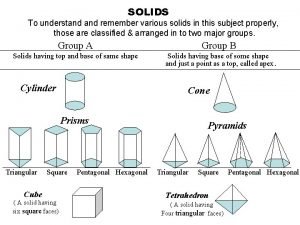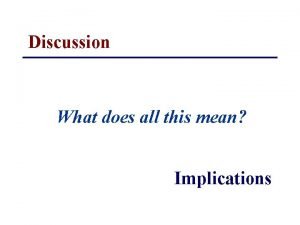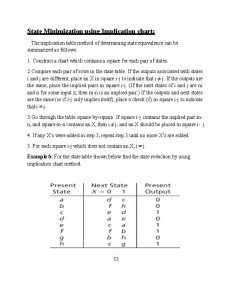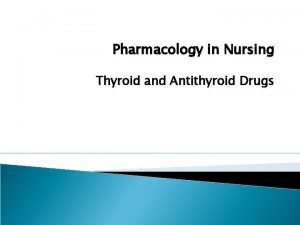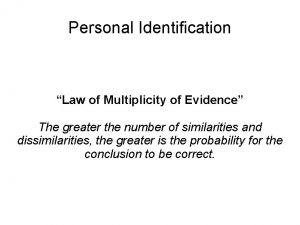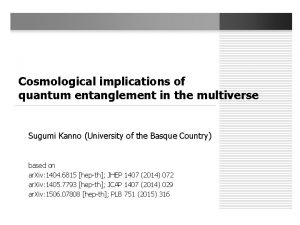List the causes and clinical implications of various






















































- Slides: 54





• List the causes and clinical implications of various electrolyte abnormalities • Describe ECG changes in potassium and calcium

Hypokalemia • Serum level below 3. 5– 5. 0 m. Eq/L • Caused by vomiting, diarrhea, diuretics, gastric suctioning , Hypomagnesemia • Muscle weakness, polyuria • Digitalis can take advantage and cause Torsades de pointes

Hypokalemia • ECG Changes – ST segment depression – T waves flatten or join U waves – U waves get larger than Ts – QT interval appears to lengthen – PR interval increases

Hypokalemia

Hypokalemia: Flat T with K~3 ST depression with prominent T (actually U) and prolonged QT when K<2. 5 -3

Hyperkalemia • Most common cause is renal failure • Sinus node can quit at 7. 5 m. Eq/L • VF or asystole at 10– 12 m. Eq/L

Hyperkalemia: T wave in hyperkalemia is typically tall and narrow, but does not have to be tall (may be just narrow and peaked pulling ST segment).

Hyperkalemia Tall T waves with a narrow base QRS widens

• Sin e waves in severe cases

Calcium • Hypercalcemia: Short QT interval • Hypocalcemia: Prolonged QT interval

Hypocalcemia: Long QT that is due to a long ST segment, which is different from long QT due to congenital long QT syndrome, drugs, or hypokalemia. T wave is not wide, there is no T wave abnormality.

Hypercalcemia: short QTc <390 ms. No significant ST or T wave abnormality

The QT Interval • Measured from the start of the QRS complex to the end of the T wave • Measures the total ventricular activity: “refractory time” • QTc is corrected for rate


139 The QT/QTc Table

• • Prolonged QT Etiologies • Familial long QT Syndrome • Congestive Heart Failure • Myocardial Infarction • Hypocalcemia • Hypomagnesemia • Type I Antiarrhythmic drugs • Myocarditis

• • Shortened QT Etiologies • Digoxin (Digitalis) • Hypercalcemia • Hyperkalemia

• Hypomagnesemia is not associated with characteristic or specific ECG findings • It is associated with a non-specific prolongation of QT and/or QRS intervals, and is often associated with hypokalemia and hypocalcemia. Therefore, changes related to the latter 2 abnormalities may be seen.






Pathologic Q Waves I 28

Progression of Myocardial Infarction • During MI the ECG often evolves through three stages: – Ischemia – Injury – Infarction 29

Identification of MI • Reciprocal changes seen on 12 lead ECG may assist with distinguishing between MI and conditions that mimic it 30

View of Inferior Heart Wall • Leads II, III, a. VF - Looks at inferior heart wall -Looks from the left leg up

View of Lateral Heart Wall • Leads I and a. VL – Looks at lateral heart wall – Looks from the left arm toward heart *Sometimes known as High Lateral*

View of Lateral Heart Wall • Leads V 5 & V 6 – Looks at lateral heart wall – Looks from the left lateral chest toward heart

View of Anterior Heart Wall • Leads V 3, V 4 – Looks at anterior heart wall – Looks from the left anterior chest

View of Septal Heart Wall • Leads V 1, V 2 - Looks at septal heart wall - Looks along sternal borders



Posterior Ischemia, Injury, Infarction • Can be identified through leads V 7, V 8 and V 9 38

Right Ventricular Ischemia, Injury, Infarction • Can be identified using leads V 3 R, V 4 R, V 5 R, V 6 R 39

Right Ventricular MI

Anterior MI

Reciprocal ST segment depression Acute ST segment elevation

Pericarditis

Pericarditis • Signs and Symptoms – Chest pain, dyspnea, tachycardia, fever, weakness, chills – Chest pain sharp, radiating to back, neck, jaw – Made worse by lying flat, twisting – Made better by leaning forward

Pericarditis • Often pleuritic pain, worse on inhalation • Pain can last for hours or days • Pericardial friction rub – Heard over left lower sternal border

Pericarditis ECG Criteria • ST segment elevation • Concave in all leads • T wave elevation • PR depression

Pericarditis

Pericarditis: Diagnosis

Early Repolarization

ECG Criteria: APE • Deep S in Lead I • Abnormal Q in Lead III • Inverted T in Lead III

140 The Digitalis Effect • • 60% of those on “Dig” have it ST segment depression Scooped out appearance Best seen in inferior/lateral leads



Questions
 List various rapid prototyping data formats
List various rapid prototyping data formats A hexagonal pyramid base 25mm side and axis 55mm long
A hexagonal pyramid base 25mm side and axis 55mm long Proximate cause and ultimate cause
Proximate cause and ultimate cause Altruistic behavior
Altruistic behavior Discussion and implications
Discussion and implications Fda debarment list clinical investigators
Fda debarment list clinical investigators Implications of database approach
Implications of database approach Constructivist approach
Constructivist approach Implications table
Implications table Nursing implications for synthroid
Nursing implications for synthroid Law of multiplicity of evidence meaning
Law of multiplicity of evidence meaning How audience negotiate meaning in mil
How audience negotiate meaning in mil Marketing implications
Marketing implications Tautological implication
Tautological implication Math
Math Progressivism educational philosophy
Progressivism educational philosophy Cengage learning
Cengage learning Nursing implications
Nursing implications Educational implications examples
Educational implications examples Legal implications of social media
Legal implications of social media Implications of nativist theory
Implications of nativist theory Implications of nativist theory
Implications of nativist theory Implikasi etis adalah
Implikasi etis adalah Educational implications of learning curve
Educational implications of learning curve Multiverse (entangled)
Multiverse (entangled) Social implications of computers
Social implications of computers Legal implications of nursing documentation
Legal implications of nursing documentation Ranexa nursing implications
Ranexa nursing implications Novolin n dosage chart
Novolin n dosage chart Educational implications of operant conditioning
Educational implications of operant conditioning Guided participation vygotsky examples
Guided participation vygotsky examples Medical implications of developmental biology
Medical implications of developmental biology What are legal implications
What are legal implications Educational implications of existentialism
Educational implications of existentialism Legal implications in nursing practice
Legal implications in nursing practice Positive inotropic agents nursing implications
Positive inotropic agents nursing implications Legal dimensions of nursing practice
Legal dimensions of nursing practice Future implications definition
Future implications definition Examples of decongestants
Examples of decongestants Fluconazole nursing implications
Fluconazole nursing implications Hát kết hợp bộ gõ cơ thể
Hát kết hợp bộ gõ cơ thể Frameset trong html5
Frameset trong html5 Bổ thể
Bổ thể Tỉ lệ cơ thể trẻ em
Tỉ lệ cơ thể trẻ em Chó sói
Chó sói Glasgow thang điểm
Glasgow thang điểm Chúa yêu trần thế alleluia
Chúa yêu trần thế alleluia Các môn thể thao bắt đầu bằng tiếng nhảy
Các môn thể thao bắt đầu bằng tiếng nhảy Thế nào là hệ số cao nhất
Thế nào là hệ số cao nhất Các châu lục và đại dương trên thế giới
Các châu lục và đại dương trên thế giới Công thức tính thế năng
Công thức tính thế năng Trời xanh đây là của chúng ta thể thơ
Trời xanh đây là của chúng ta thể thơ Mật thư anh em như thể tay chân
Mật thư anh em như thể tay chân Phép trừ bù
Phép trừ bù Phản ứng thế ankan
Phản ứng thế ankan

